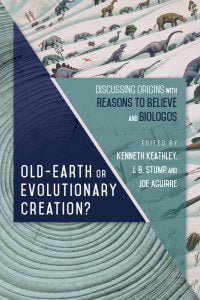 Chapter two of Old Earth or Evolutionary Creation: Discussing Origins with Reasons to Believe and BioLogos focuses on biblical interpretation. John Walton presents his view as one approach common in evolutionary creation and at BioLogos. Kenneth Samples writes for Reasons to Believe. Today we will look at John’s opening statement. The next post will focus on Ken’s presentation of his view.
Chapter two of Old Earth or Evolutionary Creation: Discussing Origins with Reasons to Believe and BioLogos focuses on biblical interpretation. John Walton presents his view as one approach common in evolutionary creation and at BioLogos. Kenneth Samples writes for Reasons to Believe. Today we will look at John’s opening statement. The next post will focus on Ken’s presentation of his view.
At BioLogos “we believe the Bible is the inspired and authoritative word of God.” Scripture is taken very seriously by everyone involved. Some prefer not to use the word “inerrancy” as the term carries some unfortunate baggage in our culture. I, personally, prefer to stick with inspired and discuss what this means rather than use other terms to construct a fence around Scripture (see Inspiration? Yes! – Inerrancy? for more on my thinking here). John Walton (Professor of Old Testament at Wheaton College) is more comfortable with the term inerrancy. In rough outline his view focuses on authority, accommodation, and message.
First, it is important to realize that the authority of Scripture rests with God and not with us as readers, or even with the original authors. But “God chose to communicate his revelation through human communicators. He thereby invested his authority in them. Scripture comes to us through human instrumentation.” (p. 29)
Second, God accommodated his message to human authors and audiences. This isn’t a cop out – it is a fundamental aspect of communication. “Every act of communication requires accommodation that will tailor the communication to the needs and circumstances of the audience, including their background beliefs about the world.” (p. 29)
Finally, the message was (usually) clear and intended by the original author. There are prophecies and oracles only fully understood much later. The New Testament authors certainly identified meanings that go beyond the original intent. Walton sees this as another example of divine inspiration. “The later New Testament author who interprets the Old Testament also enjoys the benefit of authority vested in him by God. So his message comes with divine endorsement too.” (p. 30)
However, now the canon is closed. We do not possess this authority to reinterpret. In the absence of a transcendent interpretation within the pages of Scripture, we should only view the intended meaning of the original author as inspired. “Once we move outside of the author’s intentions, we have no confidence that we are actually identifying something that God meant to say. We have no authority and neither do the meanings that we discern that are not represented in the inspired author’s intentions.” (p. 31)
With respect to the question of origins, Walton suggests that we err when we see modern cosmological models in Scripture. The Big Bang, evolution, an ancient earth, the globe, and a sun-centered solar system were unknown and are not found the Old Testament. We shouldn’t expect to find scientific concepts that are alien to the original audience. “Our interest for the interaction with science is in whether the intentions of the author make claims that inherently deny the conclusions of modern science.” (p. 32) Walton has argued (For example, Lost World of Genesis One and Lost World of Adam and Eve) that the claims being made in Genesis are not material claims of origins, but claims of purpose and function. It shouldn’t concern us when ancient cosmology is used to communicate the message. God accommodated his message to the original author and audience. “In cases of creation and the flood, interpreters are obliged only to those affirmations being made by the author as expressed in his language and understood against the backdrop of his culture. The hermeneutical principle that is too often neglected is that we must therefore read the text as an ancient text, not a modern one.” (p. 32)
The intended message of God, conveyed though human instrumentation is inerrant.
Scripture does not teach evolutionary creation, progressive creation, or young earth creation (it isn’t a science text of any age or sort). This simply isn’t part of the intended message. We should focus on the intended message.
What do you think of Walton’s line of argument?
How do we discern the intended message of Scripture?
If you wish to contact me directly you may do so at rjs4mail [at] att.net.
If interested you can subscribe to a full text feed of my posts at Musings on Science and Theology.











